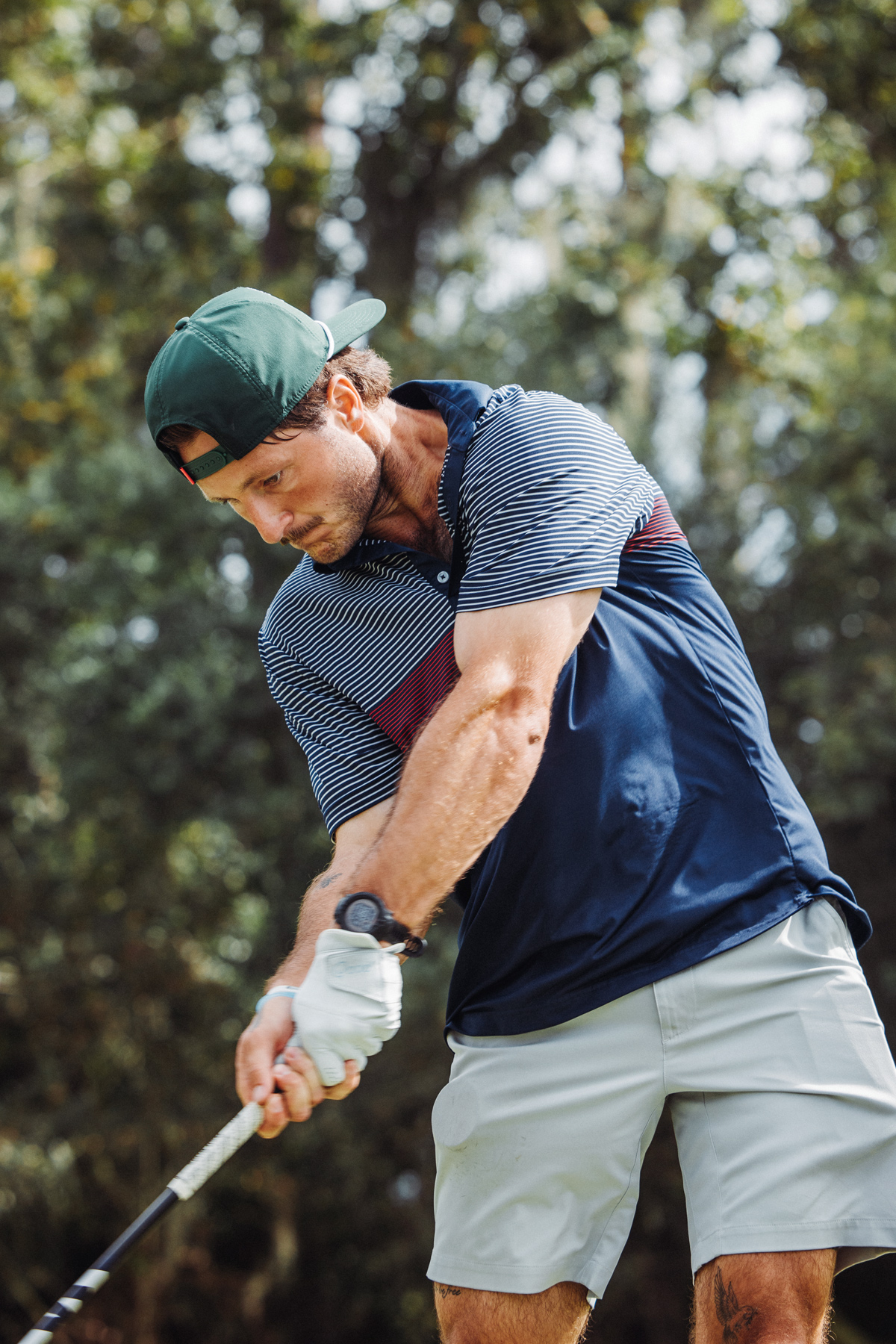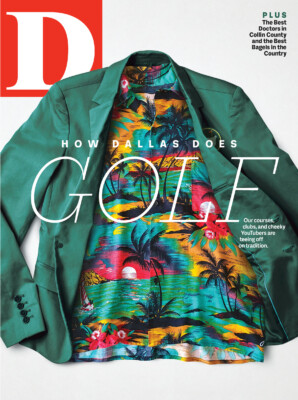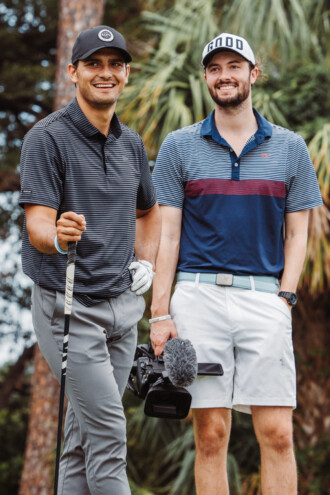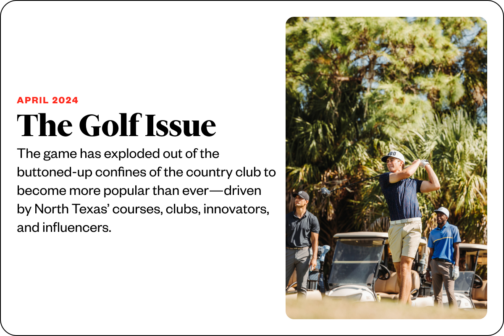
Garrett Clark was 14 when he first picked up a club. He was invited to play a six-hole par-3 course with his neighbor in Kansas City. “I hated every minute of it,” he says, “but we happened to tie, and he told me we couldn’t end in a tie.” So the two friends backtracked 85 yards to the tee box on the sixth hole for a playoff. The tall, lanky Clark hit a 7-iron perfectly. The ball landed in the cup for a hole-in-one. “After that, I was convinced: I was so good at this sport,” he says. “In my brain, I interpreted it as this is my calling.”
Clark was half right. He didn’t stumble upon a generational talent that would lead him to tournaments at Augusta, St. Andrews, or Sawgrass, but he did find his calling. A calling that has led him to co-captain the rise of Good Good Golf, a group of twentysomething guys sparking a revolution at the intersection of golf and media. What manifests in front of the camera for golf’s boy band has shaken up how young fans consume their favorite sport, how global media companies think about content, and how golf manufacturers approach marketing. Consider the numbers: they perform in front of a YouTube audience of nearly 1.5 million subscribers—100,000 more than the PGA Tour’s official YouTube channel and over 1 million more than the channel for the new tour backed by Saudi Arabia. Good Good was the second YouTube channel to reach 1 million subscribers in the golf category. Clark’s personal channel, GM Golf, was the third channel to reach the milestone.
They have a YouTube audience of nearly 1.5 million, 100,000 more than the PGA Tour’s official channel.
Clark started filming as a preteen, uploading YouTube videos of himself playing the piano and building sets of Legos. As he grew older, the Kansas City native’s mother was not too fond of social media, but she acknowledged it might help him get recruited by college golf coaches. As he started uploading videos, the number of junior golf tournaments he played each year dwindled from 30 to just three in his final season. His videos quickly turned from highlight tapes of 18-hole matches and range sessions to wild trick shots. But soon after his channel grew to 30,000 followers, the NCAA called his dad and made the family aware that Clark would be deemed ineligible due to name, image, and likeness rules at the time. Clark is adamant that, at this point, he had not made any brand sponsorship money off YouTube.
To keep his golf and YouTube careers going, he enrolled at Kansas City Kansas Community College. “I think there was a span of 90 days where I uploaded 90 videos, all while I was in school and traveling for college golf,” he says. “After that, I fell into a rut. The videos weren’t doing great, and I was going to quit YouTube.” The winter night he decided to give it all up, he went to IHOP with fellow future Good Good member Stephen Castaneda. “I made $12 yesterday, dude. I need to get a real job like at McDonald’s or something to get myself through college,” Clark told his friend. “No,” Castaneda replied. “Give it two more weeks, and I’ll start filming with you, and we’ll see if that helps.” Clark also roped childhood friend Matt Scharff into the act, and the trio got GM Golf rolling. In just three months, the channel grew from 30,000 to 170,000 subscribers. “It was all thanks to having more personalities involved,” Clark says.
At the end of his first year of college, Clark considered dropping out to pursue YouTube full time. He hated college anyway. His father, a financial adviser, wasn’t as bullish, but he gave his son a challenge. “He told me if I made $60,000 off YouTube by the time summer ends, I could drop out,” Clark says. At the time, he had made a mere $5,000 off content creation and had three months to make the rest. But with the introduction of his friends on the channel, Clark did it. “You’d be stupid not to drop out,” Clark’s father told him. A year or so later, Clark’s cousin Micah Morris joined him full time on the channel, and GM Golf continued to climb up the charts.

Bogey Boys. Birdie Boys. The Sandbaggers. They were all names kicked around by Clark, Castaneda, Scharff, and Morris when the group was being formed in 2020. “We sat there for 45 minutes talking about all these cringey names,” Clark says. Then CEO Matt Kendrick piped up: “Maybe we should call it Good Good.” The boys loved it. Kendrick, who had previously overseen the popular YouTube fishing channel Googan Squad, had been sitting on the company name since his college days. “Immediately, I knew we were going to be a successful company just based off the name alone,” Clark says.
Good Good’s name, of course, derives from the golf course. Two recreational golfers walk onto the putting green. Their golf balls are relatively close to the hole—say, within 3 feet. One looks at the other and asks, “Good, good?” The other replies, “Good, good.” The two pick up their balls, record their score as if they both made those short putts, and move on to the next hole.
Kendrick suggested that Clark, Morris, Castaneda, and Scharff move down to Frisco. It was far easier for him to move a bunch of college-aged kids than it was for him to move his family up to Kansas City. Kendrick also got pro golfer George Bryan and Brice Butler to appear in videos—yes, the same Brice Butler who played wide receiver for the Dallas Cowboys from 2015 to 2017.
Their first video was a house tour of where all the guys lived. Like any hip YouTube group, a frat house was necessary. Only this wasn’t a raggedy animal house—it was a 6,000-square-foot Allen residence they leased from former Mavericks player and Texas Legends coach DeSagana Diop.
“I was looking to get plugged into the media space after my playing career, and my buddy and I started video reviewing golf resorts,” Butler says. “And before Good Good existed, at the start of the pandemic, I got invited to play golf with a bunch of guys at Pursell Farms in Alabama.” At the time, it was the right fit for everyone. But the content was all over the place. The guys did a guacamole-making challenge, played a 2v2 pickleball match, and went to a waterpark and filmed themselves sliding around. A few golf videos were intermingled with their off-course content, but the long-term vision was far from fleshed out.
“The initial idea for Good Good is not at all what it is today,” Clark says. “All of our individual members at the time had been filming golf content on our own channels, so we thought it might be best to film everything but golf on the Good Good channel.”
“We quickly realized people don’t want to watch golfers film non-golf content.”
Butler and Bryan stopped filming with the group shortly after its formation. Kendrick says the two family men couldn’t uproot and move to Texas as easily as college-aged kids; Butler denies that’s the reason, but he chose not to elaborate. Instead, Chicago native and college caddie Thomas “Bubbie” Broders, who was connected with Kendrick’s Googan Squad, and former college golfer Grant Horvat, a good friend of Clark’s, rounded out the six-man group. The guys found virality as Broders holed out from 90 yards in his very first video, and Scharff jarred a hole-in-one on a 290-yard uphill par 4, which made the rounds all over, leading to an appearance on SportsCenter. Since then, Scharff has made two more hole-in-ones on camera, including a second ace on a par 4.
The boys’ videos include head-to-head stroke-play matches, 3v3 scramble matches, “knockout challenges” in which the golfer with the worst score on a hole gets eliminated until there’s one golfer left, and “wheel of not ideal challenges” in which they spin a prize wheel before every shot and are forced to play with the club indicated. At every significant course the group visits, they film a Good Good Major featuring all the guys playing 18 holes, with the lowest scorer winning a trophy. It all adds up to a rabid fan base that has even created a Good Good Reddit forum, which has more than 34,000 members.
Good Good’s rise couldn’t have happened at a better time. Following the pandemic, golf of all types—pro and recreational, on-course and off-course (think Topgolf or indoor simulators)—boomed. It has resulted in another golden moment for the sport. Across the country, golf, which has traditionally been identified as a high-net-worth, white-collar, country-club sport, has never been more accessible and more popular than it is right now.
In 2019, 108 million Americans over the age of 5 either followed golf on television or online, read about the game, listened to a golf-related podcast, or played golf somewhere. Today, the sport has ballooned to more than 123 million participants. And in 2023 alone, more than 3.4 million people played their first round.
The subset growing the most is 16- to 34-year-olds, the generation Good Good members are part of. Their content struck a chord, helping pave the way for YouTube to turn into a leading forum for golf fans to consume the sport. In essence, these golf channels have become the sport’s sitcoms. All the iconic ones—Seinfeld, Cheers, Friends, Gilligan’s Island—have one thing in common: the scriptwriters were able to craft a group of characters that gave most viewers at least one to identify with. For young golf fans, the same goes for the cast of Good Good—only nothing is scripted. It’s just a group of average-to-good golfers hitting a ball around the course and having fun.
By 2021, Good Good had become much more than just a group of guys goofing around on a golf course. Brand deals and partnerships started pouring in, the most groundbreaking of which was with what is now Topgolf Callaway Brands Corp. After executing a two-year, seven-figure deal to promote Callaway products, the California-based manufacturer dropped Good Good-branded putters and golf balls. According to Nick McInally, Callaway’s VP of marketing, the Good Good putters and golf balls set a Callaway record for the fastest items to sell out.

The hallmark of any iconic boy band, of course, is a breakup—one that leaves everyone with questions. In 2022, Grant Horvat and Micah Morris left Good Good, dropping the band down to four. It was a shake-up that left the remaining members stunned, not to mention fans. Morris’ exit was more comprehensible for the group. He was the oldest—five years older than most of the members, married, and reportedly still trying to break through on the pro tour. But the departure of Horvat so soon after he had entrenched himself as a face of the brand left everyone scratching their heads. Horvat, who was engaged to be married at the time, had become the Niall Horan to Garrett Clark’s Harry Styles or the Danny Wood to Clark’s Donnie Wahlberg. And just like Joey Fatone was blindsided by Justin Timberlake’s departure from NSYNC, Clark felt the same when Horvat called to tell the guys he was done.
“Before we even knew Micah was considering leaving, he was gone,” Clark says. “But he’s my cousin, so I could deal with it. Grant leaving hurt me a lot more. We don’t know if our deal with Callaway had anything to do with it”—rumor has it, Horvat had a TaylorMade deal in the works—“but we told him he could be a part of Good Good without signing with Callaway. We tried everything we could to keep Grant. Like Bubbie has said before, we threw the kitchen sink at him for a lot of reasons, but there was nothing we could do.” Kendrick took it a step further with his assessment: “Grant, I think he just got overwhelmed,” the CEO says. “We were moving really fast, we had a lot going on, and, to me, Grant leaving felt almost like a defense mechanism. ” To this day, golf YouTube conspiracy theorists make videos about why Horvat left Good Good.
The bad blood is behind the boys, as Morris and Horvat have since made up with the group and have started collaborating on content. But rejoining the boy band is probably nothing but a pipe dream for Good Good fans. “Our travel schedule is very rigorous—we’re only home in Dallas 10 to 12 days out of the month,” Broders says. “So, I totally respect the fact that they are two people who felt they were in different seasons.”
Today, founding members Clark, Scharff, and Castaneda are still the group’s core. Broders, the fourth longest-tenured member, is the life of the party. Kendrick snagged AJ Pujols, a former college golfer and the son of former pro baseball player Albert Pujols, as a rotating cast member. And he beefed up the group with two former professional golfers, Luke Kwon and Brad Dalke.
For Dalke, Good Good was his life raft. The former top-five-ranked junior golfer (from age 13 to 18) turned into a two-time All-American at the University of Oklahoma and went pro after graduating. But past successes didn’t translate professionally. He struggled to find permanent status on any pro tour but did manage to qualify for and compete in the 2017 Masters and 2017 U.S. Open; he missed both cuts. After four years of struggling through swing changes, poor performances, and a little more than $40,000 in career earnings, his sponsors pulled the plug. “I was constantly stressed out, emotionally drained, and I got to a point where I didn’t want to play tournaments anymore,” Dalke says. “The odds are most of the guys playing mini tours probably won’t make it, but I was clinging to the dream until the money ran dry. And after it ran out, there was nothing I could do.”

In March 2023, when Good Good showed up for a week of filming at his home course, Oak Tree National in Edmond, Oklahoma, Clark invited him to join in on a video. Dalke did not have any sponsor money or prospects coming his way, so one video led to two, which led to Dalke taking trips with the crew, which resulted in him signing a merchandise sponsorship deal with Good Good, which led to Kendrick later offering the golfer, who committed to OU at 12 years old, a contract to join Good Good full time in August 2023. By the following January, in just six months, his earnings as a social media golfer eclipsed the cash he made as a professional. “If you add the earnings from what I make from my personal YouTube channel to my Good Good earnings,” he says, “then I’ve made a little more in this space than I did as a pro.”
It’s a story the golf world could start to see more of. Why would a struggling golfer, with a marketable personality, whose thirst for competition is slowly slipping away, choose to tough it out on mini tours when a platform like YouTube has produced financial stability for a handful of tour castaways?
Kwon—who has played in 47 PGA Tour events, collected nearly $790,000 in earnings over his career, and has one win to his name—left the tour and began replacing Morris in Good Good videos in September 2022. “On the money side of things, everything matters,” Kwon said on The Rough Cut Golf Podcast. “A 6-foot putt could cost you so much money depending on where you are on the leader board. But do I want to play pro golf again? Honestly, I don’t have that itch anymore. In 2018, I still had the itch, and I started my personal YouTube channel to find investors to scratch my itch. Now, I’m trying to get away from the good golfers, and if I can go play against not as good of golfers for comparable money, sign me up.”
Kendrick is unwilling to disclose Good Good’ s 2023 revenue but says the company doubled its earnings as compared to 2022. The on-screen talent is also reluctant to discuss their financials, but Clark pulled up to Good Good HQ for his interview in a matte-black Audi R8 Performance Spyder, which has an MSRP of $160,000. Broders was shocked by the first bonus check he got from Kendrick in December 2021. “We had a meeting with the business partners, and they sat us down and shared what we were getting paid. I remember hearing that number and saying, ‘Damn, that’s pretty f—ing dope,’ ” Broders says with a laugh.
According to most sources, YouTube videos produce between $10 to $30 for every 1,000 views. When this article was written, Good Good—which earns just a small portion of its revenue from its YouTube channel—had 442 videos up with more than 363 million views. If Good Good lived in the median, at $20 per 1,000 views, that would put the channel’s earnings at more than $7.25 million. “In 2024, we expect to grow our total revenue by 50 percent,” Kendrick says.

In late 2023, the Good Good team was huddled around a table in a pitch meeting with a very prominent alcohol company. The deal being proposed was a lucrative partnership, but there was only one problem. Broders is a recovering drug-and-alcohol addict. All the guys turned toward Broders to see if he would feel comfortable with the partnership. “To be honest, if it’s the best move for the company, I support it,” Broders said. “But I cannot be in any ads or ad reads promoting alcohol. I just can’t do that.” Without hesitation, Broders says, all the guys came to an immediate conclusion that if he was not comfortable with it, then the company was not going to pull the trigger on the deal. “That’s just a testament to how supportive and amazing this group is,” he says.
The Good Good team’s brotherhood isn’t limited to the onscreen talent. It has grown to include its camera crew and production team: Max Putnam, Collin Ross, Luis Hinojos, Cade Zarnowski, Michael Hsu, and more. And it seems everybody wants a piece of that camaraderie. At the beginning of 2024, NBC Sports struck a deal with Good Good to broadcast a 14-hole scramble tournament featuring dozens of influencers, the Good Good Desert Open, live on Peacock. Intended as an appetizer to the debauched WM Phoenix Open, the stream peaked at more than 100,000 viewers. “We understand the value of Good Good,” says Glenn Grimshaw, the VP of franchise development at NBC Sports. “And it only makes sense that we continue to work on projects with them for the good of golf.”
A year prior, Good Good put on a revolutionary 63-man pro tournament for mini-tour golfers in Scottsdale, Arizona. Sponsored by Golf Galaxy, the tournament had a purse of $100,000, with the winner claiming $50,000. Compare that to most mini-tour events, where players pay an entry fee of around $1,000 for a chance to win a first-place prize of less than $10,000. At best, the top 10 percent of the leader board breaks even.
In addition to the video content, Good Good Golf ventured into apparel just six months after its first video. Today, the brand is in more than 300 Golf Galaxys and every Scheels location. According to Kendrick, the apparel brand was competing with Lululemon to sign Min Woo Lee to an apparel endorsement, but the star golfer opted to become the face of Lululemon instead. “We were gonna bet a lot of money on Min,” the Good Good CEO says. “It was an uphill battle, for sure, but we almost got him.”
Last year was a banner year for Good Good’s growth, but 2024 will be about entering new mainstream media markets. Good Good will be part of the third season of Netflix’s Full Swing. “Netflix was on-site with us at the American Express golf tournament while we filmed with Min Woo Lee,” Kendrick says. He is also pitching around a docuseries on Good Good to different production studios. “The series might live on Netflix, Peacock, or Max,” he says. “But the producers we’re working on this with produced Ozark for Netflix.”
In addition, Kendrick says Good Good is in discussions with the Golf Channel to bring The Big Break back. The reality TV show, which aired for 23 seasons from 2003 to 2015, featured aspiring professional golfers competing for exemption status into PGA Tour events or full-time exemptions onto lower-level tours. At 19 years old, an aspiring Tony Finau appeared on the show in 2009. He now has six PGA Tour victories.
“We know the content that Good Good puts out through their channels is fun, it’s young, and they are really good at engaging that particular audience,” Grimshaw says. “But in terms of the specificity around The Big Break, I’m not going to approve or deny what’s going on there.”
For all companies in golf, it comes down to capturing a younger audience. Grimshaw says the average golf fan who consumes the sport on linear television is in their 60s. But Good Good is capturing the golf audience of 16 to 34 to the tune of more than 820,000 views per video. Callaway struck a partnership with Good Good for the same reason.
“Our focus is reaching passionate golfers, and the Good Good partnership is huge for us because it allows us to reach a core audience that all golf brands have struggled to reach in the past,” McInally says.
Additionally, Kendrick says to keep an eye out for a Good Good brick-and-mortar store should the right real estate opportunity present itself. Good Good was in discussions to open its first at the Omni PGA Frisco, but the space was awarded to Vineyard Vines instead.
“We are creating a company that we want to be known well beyond the faces of content,” Broders says. “We’re just this global golf brand that somehow these 20-year-old kids were able to start out of Frisco, Texas. And five years down the road, we will be rivaling the biggest players in the game.”
Each member is aligned on that thinking. And each is prepared for a long-haul scale that includes manufacturing a full suite of clubs, bags, and more. “At the end of the day, we want to go compete one day with the Titleists and TaylorMades of the world,” Kendrick says. “We’re just building a golf company different. It’s going to take years to develop our own golf clubs and really break into the ball market, but we know our great content is building a great brand and once we’re ready to put out products, the golf marketplace will trust that we can deliver at a high level.
“So, 10 years from now, are we a staple golf company? Yes. Are we the most entertaining golf company in the world? Yes. And are we a massive media company? Yes.”
Ed. Note: On April 3, after this story was already on newsstands, Luke Kwon announced that he was leaving Good Good to “take a bet on myself.”
This story originally appeared in the April issue of D Magazine with the headline “The Boy Band of the Links.” Write to [email protected].
Author













